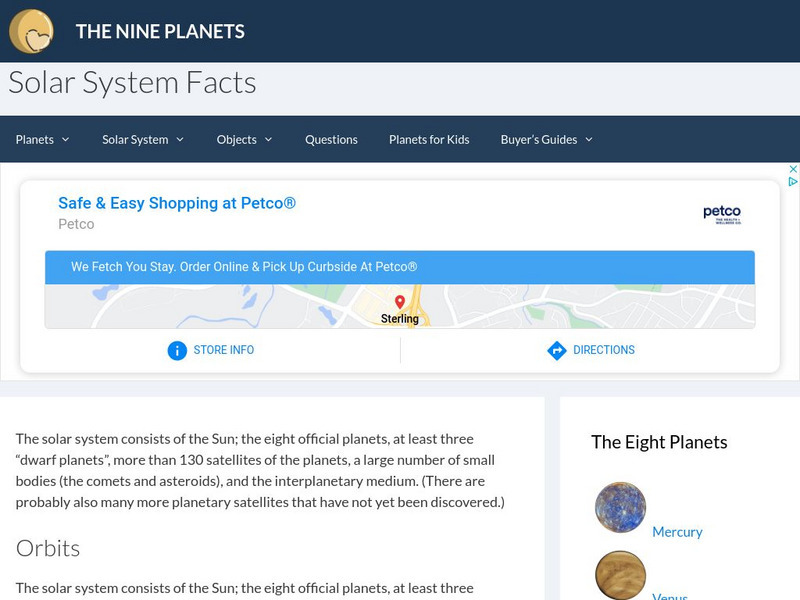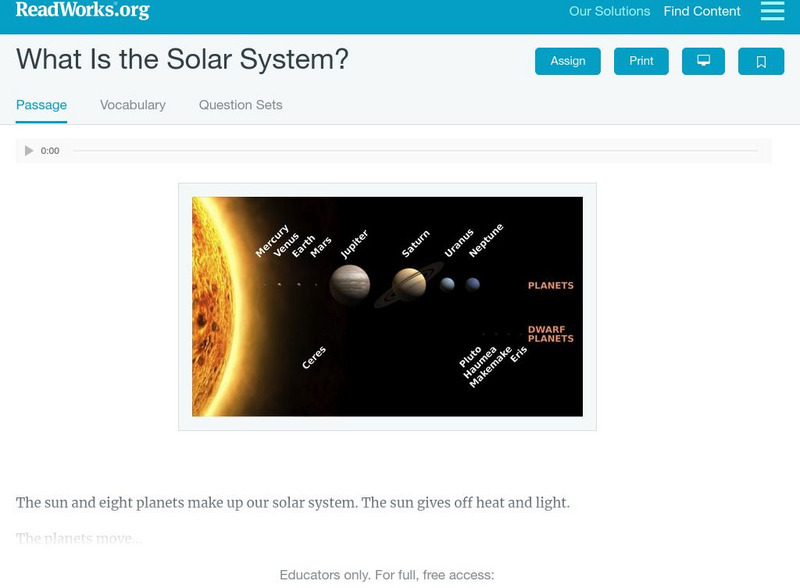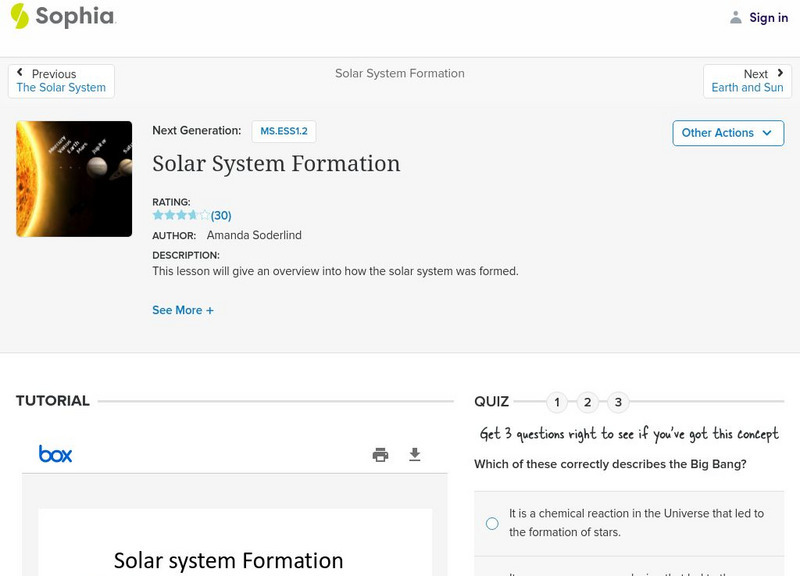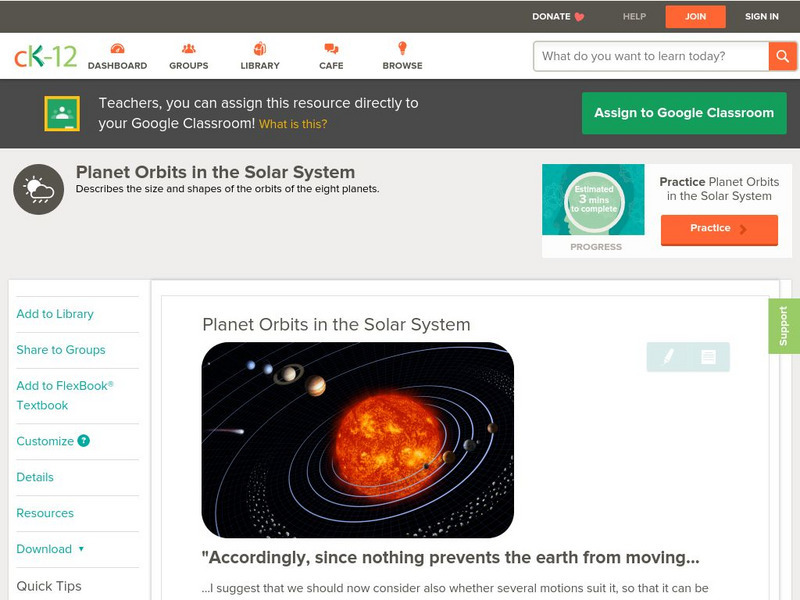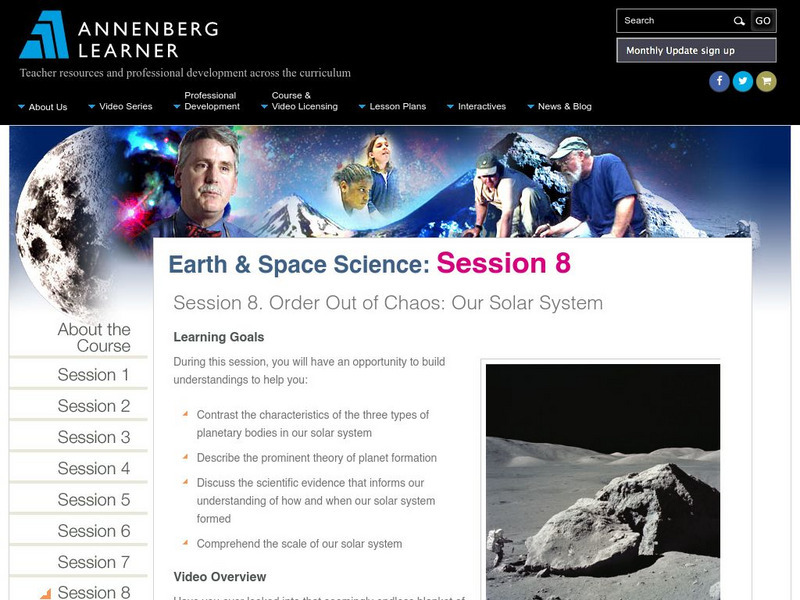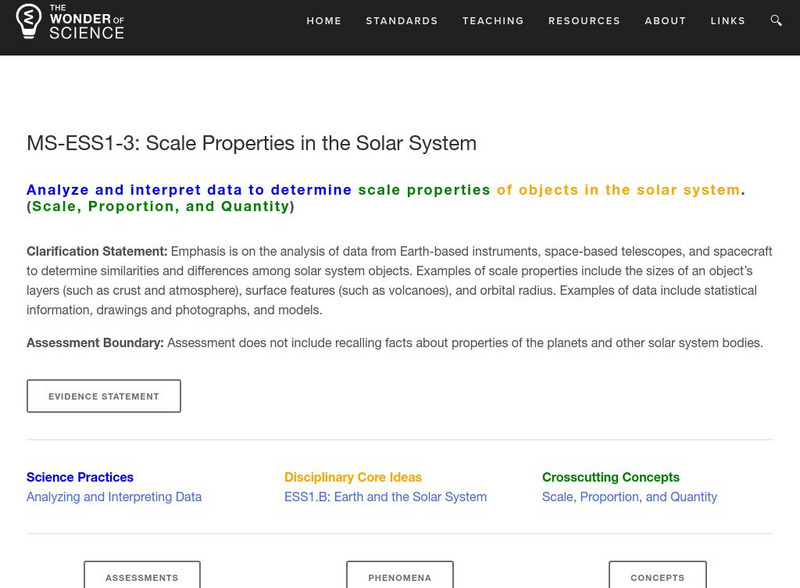PBS
Pbs Learning Media: All Planet Sizes
This illustration from the Lunar and Planetary Laboratory shows the approximate sizes of the planets relative to each other. Note that the planets are not shown at appropriate distances from the Sun.
Nine Planets
The Nine Planets: An Overview of the Solar System
A detailed overview of the history, mythology, and current scientific knowledge of each of the planets and moons in the solar system.
NASA
Nasa: Our Solar System Overview
This site has links to all the planets, providing an overview of the solar system. It also contains information about asteroids, meteors, comets and other features of our solar system.
Read Works
Read Works: What Is the Solar System?
[Free Registration/Login Required] An informational text about the solar system. A question sheet is available to help students build skills in reading comprehension.
Education.com
Education.com: The Solar System: Learning About Planets
[Free Registration/Login Required] Learn all about the components of the solar system with this downloadable lesson plan. Includes several student handouts and a research activity.
Khan Academy
Khan Academy: How Our Solar System Formed
An article describing how the sun, planets, moons, and beyond Pluto was formed. Learn more about the beginning of our solar system.
Sophia Learning
Sophia: Solar System Formation
An illustrated slide show highlighting the origin and make-up of our solar system.
NASA
Nasa: Solar System Exploration: Planets: Venus
Comprehensive look at the planet Venus, with many useful facts, figures, photos, and related links. Provides an account of how Venus got it's name and a timeline of significant dates.
Other
Space Science Institute: Alien Earths: Star and Planet Formation
Learn about the lives of stars, and how stars and planets form. The Interactive activity, 'Planet Families' requires Adobe Flash and cannot be launched.
CK-12 Foundation
Ck 12: Earth Science: Planet Orbits in the Solar System
[Free Registration/Login may be required to access all resource tools.] Looks at the size and shape of planet orbits.
Scholastic
Scholastic: Study Jams! Science: Our Solar System: The Universe
A video and a short multiple-choice quiz on the Universe and what it is made up of.
Harvard University
Harvard University: The Solar System
These hands-on activities are a great way for students to gain perspective on the relative sizes and distances of each planet, the relationship between the sun and Earth, and much more.
Annenberg Foundation
Annenberg Learner: Earth and Space Science: Order Out of Chaos: Solar System
Material to begin an exploration of the Solar System: the characteristics of the planets, theories about planet formation, and more. An hour-long video is accompanied by learning goals, an outline and overview, details on star formation,...
Science Education Resource Center at Carleton College
Serc: Build Your Own Solar System
This Java applet creates a model of a solar system with user-defined data. Users can create a solar system with up to four planets, choosing the star type at the center of the solar system, planet name, size, eccentricity of orbit and...
Other
Making a Scale Model of the Solar System
In this lesson plan site, learners are asked to construct a scale model of the planets to help visualize the relative size of planets and their relative distance from the Sun. Links are provided to the Sun and the planets which contain...
Polk Brothers Foundation Center for Urban Education at DePaul University
De Paul University: Center for Urban Education: Learning About the Solar System [Pdf]
"Learning about the Solar System" is a one page, nonfiction, reading passage about scientists and learning about our solar system and how it works. It is followed by constructed-response questions which require students to provide...
The Wonder of Science
The Wonder of Science: Ms Ess1 3: Scale Properties in the Solar System
Work samples, phenomena, assessment templates, and videos that directly address standard MS-ESS1-3: scale properties in the solar system.
Utah Education Network
Uen: My Solar System
Young scholars will use a simulation to build their own solar system discovering the relationship between gravity and motion that keeps a planet in orbit.
NASA
Nasa: Space Place: Solar System Switch a Roo
Play this creative puzzle game where the player views a solar system object that is all mixed-up. Try and find the matching parts of the photograph, and learn about the solar system in the process.
Texas Instruments
Texas Instruments: Solar System
This activity is designed to assess the comprehension of concepts related to the planets and other astronomical bodies in the Solar System.
Polk Brothers Foundation Center for Urban Education at DePaul University
De Paul University: Center for Urban Education: Learning About the Solar System [Pdf]
"Learning about the Solar System" is a one page, nonfiction, reading passage about the Milky Way gallaxy and what it takes to be a scientist. It is followed by constructed-response questions which require students to provide evidence...
Polk Brothers Foundation Center for Urban Education at DePaul University
De Paul University: Center for Urban Education: Learning About the Solar System [Pdf]
"Learning about the Solar System" is a one page, nonfiction, reading passage about the Milky Way gallaxy and how scientists learn about it over time. It is followed by questions which require students to provide evidence from the story;...
National Geographic
National Geographic: Extreme Weather on Other Planets
Examine the variety of weather found on all of the planets in the solar system with this classroom exercise. Students will see a video and observe differences and similarities among the planets.
Other
All (Known) Bodies in Our Solar System Larger Than 200 Miles in Diameter
How big is the Earth compared to the Sun? Is Mars bigger than the Moon? Seeing all bodies in the solar system larger than 200 miles in diameter side by side provides an excellent comparison and an interesting perspective.

